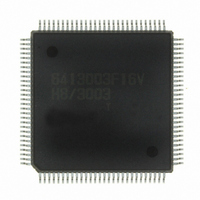D13003TF16V Renesas Electronics America, D13003TF16V Datasheet - Page 243

D13003TF16V
Manufacturer Part Number
D13003TF16V
Description
IC H8/3003 ROMLESS 112QFP
Manufacturer
Renesas Electronics America
Series
H8® H8/300Hr
Datasheet
1.D13003TF16V.pdf
(717 pages)
Specifications of D13003TF16V
Core Processor
H8/300H
Core Size
16-Bit
Speed
16MHz
Connectivity
SCI
Peripherals
DMA, PWM, WDT
Number Of I /o
50
Program Memory Type
ROMless
Ram Size
512 x 8
Voltage - Supply (vcc/vdd)
2.7 V ~ 5.5 V
Data Converters
A/D 8x10b
Oscillator Type
Internal
Operating Temperature
-20°C ~ 75°C
Package / Case
120-TQFP, 120-VQFP
Lead Free Status / RoHS Status
Lead free / RoHS Compliant
Eeprom Size
-
Program Memory Size
-
Available stocks
Company
Part Number
Manufacturer
Quantity
Price
Company:
Part Number:
D13003TF16V
Manufacturer:
RENESAS
Quantity:
210
Company:
Part Number:
D13003TF16V
Manufacturer:
Renesas Electronics America
Quantity:
10 000
- Current page: 243 of 717
- Download datasheet (2Mb)
Figure 8-19 shows the timing when channel 0A is set up for I/O mode and channel 1 for burst
mode, and a transfer request for channel 0A is received while channel 1 is active.
Multiple-Channel Operation in Different Groups: If transfers are requested on channels in
groups 0 and 1 simultaneously, or if a transfer in one group is requested during a transfer in the
other group, the DMAC operates as follows.
•
•
•
•
ø
A
RD
HWR
23
When a transfer is requested, the DMAC requests the bus right. When it gets the bus right, it
activates the highest-priority channel at that time. If there are transfer requests for both
DMAC groups 0 and 1, a channel in group 0 is activated.
Once a transfer starts on a channel in one group, requests to other channels are held pending
until that channel releases the bus.
After each transfer in short address mode, and each externally-requested or cycle-steal
transfer in normal mode, the DMAC releases the bus and returns to step 1. If there is a
transfer request for a channel in the other group, that channel is activated immediately.
After completion of a burst-mode transfer, or after transfer of one block in block transfer
mode, the DMAC releases the bus and returns to step 1. If there is a transfer request for a
group-0 channel while a group-1 channel is active, however, the group-1 channel releases the
bus after completing the transfer of the current byte or word. When the bus is released, if
there is a transfer request for a channel in the other group, the DMAC is activated
immediately.
to A
,
LWR
0
Figure 8-19 Timing of Multiple-Channel Operations in the Same Group
DMAC cycle
(channel 1)
T
1
T
2
T
1
CPU
cycle
T
2
T
d
T
1
DMAC cycle
(channel 0A)
223
T
2
T
1
T
2
T
1
CPU
cycle
T
2
T
d
T
1
DMAC cycle
(channel 1)
T
2
T
1
T
2
Related parts for D13003TF16V
Image
Part Number
Description
Manufacturer
Datasheet
Request
R

Part Number:
Description:
Rectifier diode. All purpose high power rectifier diodes, Non-controllable and half controlled rectifiers. Vrrm = 200V, Vrsm = 300V.
Manufacturer:
Usha Ltd.

Part Number:
Description:
Rectifier Diode, 800V, 130A, Silicon Diode, All purpose high power rectifier diode
Manufacturer:
Usha Ltd.

Part Number:
Description:
KIT STARTER FOR M16C/29
Manufacturer:
Renesas Electronics America
Datasheet:

Part Number:
Description:
KIT STARTER FOR R8C/2D
Manufacturer:
Renesas Electronics America
Datasheet:

Part Number:
Description:
R0K33062P STARTER KIT
Manufacturer:
Renesas Electronics America
Datasheet:

Part Number:
Description:
KIT STARTER FOR R8C/23 E8A
Manufacturer:
Renesas Electronics America
Datasheet:

Part Number:
Description:
KIT STARTER FOR R8C/25
Manufacturer:
Renesas Electronics America
Datasheet:

Part Number:
Description:
KIT STARTER H8S2456 SHARPE DSPLY
Manufacturer:
Renesas Electronics America
Datasheet:

Part Number:
Description:
KIT STARTER FOR R8C38C
Manufacturer:
Renesas Electronics America
Datasheet:

Part Number:
Description:
KIT STARTER FOR R8C35C
Manufacturer:
Renesas Electronics America
Datasheet:

Part Number:
Description:
KIT STARTER FOR R8CL3AC+LCD APPS
Manufacturer:
Renesas Electronics America
Datasheet:

Part Number:
Description:
KIT STARTER FOR RX610
Manufacturer:
Renesas Electronics America
Datasheet:

Part Number:
Description:
KIT STARTER FOR R32C/118
Manufacturer:
Renesas Electronics America
Datasheet:

Part Number:
Description:
KIT DEV RSK-R8C/26-29
Manufacturer:
Renesas Electronics America
Datasheet:

Part Number:
Description:
KIT STARTER FOR SH7124
Manufacturer:
Renesas Electronics America
Datasheet:











